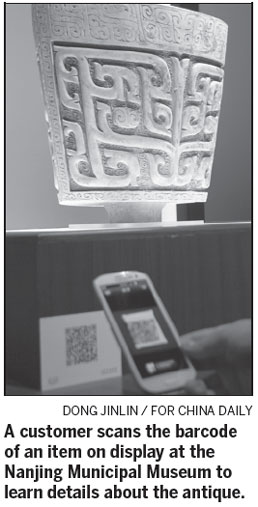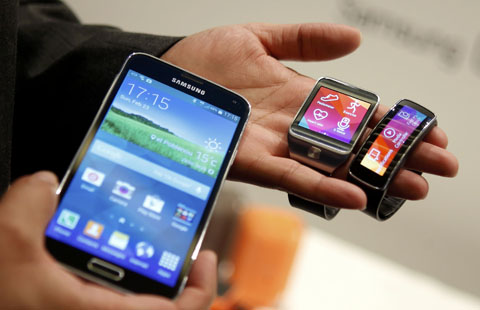Museum catches up with technology
Updated: 2014-03-01 10:20
By Xinhua in Nanjing (China Daily)
|
||||||||
In an exhibition hall of the Nanjing Municipal Museum, Wang Xiaoqi is squatting down with her cellphone while scanning the barcode of a porcelain vase.
The vase is among the 40-plus miscellaneous antiques on display in NMM in Nanjing, capital of East China's Jiangsu province. Each antique has a quick response code that details its history when scanned by cellphones.
"Not only can I upload the information on the vase to my microblog, but also store the description on my phone and study it when I get home," Wang says.
The NMM has just updated the newest description of the antiques this week, after starting to barcode the collection in mid 2013, according to Wu Tian, deputy curator of the museum.
"Our visitors have shown great enthusiasm for the program since it began last year," Wu says.

Wu says that because young people are interested in sharing information on social networks like WeChat, a popular instant messaging application, the museum has put more emphasis on interaction.
Such programs have changed the way people view traditional culture, making it easier for them to accept it, according to Zhou Keda, of the Guangxi Academy of Social Sciences.
While the novelty might wow visitors, Zhou says that the revamp masks a wider and increasingly urgent problem that is playing out in a country awash with modern gadgets like tablets and smartphones.
"Many people have grown bored with the old ways of learning in museums, lectures and classrooms," Zhou says.
As urgency for change mounts, scores of museums in China are jumping on the bandwagon and applying technology to their exhibits.
Back in May 2013, the Palace Museum, also known as the Forbidden City, in central Beijing launched its first iPad application, and had 150,000 downloads within the week. It was later voted excellent app of the year in China.
The Palace Museum followed that success with a public account on WeChat in January, which allows followers to enjoy ancient architecture, antiques and special exhibitions on their portable devices, giving the museum extra firepower in bringing cultural relics to the general public.
Elsewhere, a renowned history museum in the northwestern Shaanxi province launched a smartphone application that combines pictures, text and voices in December 2013.
As modern technology has crept into every facet of life, it is a smart move to create a tie-up between Chinese culture and gadgets, says Gong Liang, curator of the NMM.

 Gorgeous Liu Tao poses for COSMO magazine
Gorgeous Liu Tao poses for COSMO magazine
 Post-baby Duchess
Post-baby Duchess
 Victoria Beckham S/S 2014 presented during NYFW
Victoria Beckham S/S 2014 presented during NYFW
 'Despicable' minions upset Depp's 'Lone Ranger' at box office
'Despicable' minions upset Depp's 'Lone Ranger' at box office
 'Taken 2' grabs movie box office crown
'Taken 2' grabs movie box office crown
 Rihanna's 'Diamonds' tops UK pop chart
Rihanna's 'Diamonds' tops UK pop chart
 Fans get look at vintage Rolling Stones
Fans get look at vintage Rolling Stones
 Celebrities attend Power of Women event
Celebrities attend Power of Women event
Most Viewed
Editor's Picks

|

|

|

|

|

|
Today's Top News
Houston-China bonds deepen with new group
Apple Inc sues China on IP
Climate law summit started in DC
China issues report on US human rights
Scholars from and on China
Baidu gets 'buy' rating from street
Program to help US minority youth
China ignores time bomb of increasing waistlines
US Weekly

|

|







